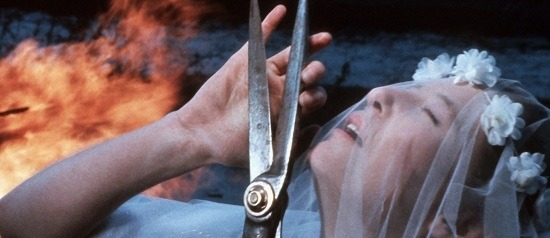
Derek Jarman's The Last of England
SERIES
Poets of Pandaemonium: The Cinema of Derek Jarman and Humphrey Jennings
February 8–17, 2019The films of Humphrey Jennings and Derek Jarman are separated by a gulf of decades, decades in which their native Britain metamorphosed from a world power into a melancholy little island. They were both radical in their employment of audiovisual montage, non-professional actors, and their frequent use of recited poetry—though Jennings utilized these techniques in the espousal of his signature brand of optimistic patriotism, while Jarman was preoccupied by the psychological strife of late-twentieth-century queer life. The two artists shared a detached skepticism of the cinematic medium: As accomplished abstract painters, skilled theatrical designers, and acclaimed authors they saw the cinema as only one facet of their voluminous oeuvres. Such a detachment may have been the secret ingredient to the success of their distinctive, and at times shockingly parallel, film experiments.
Derek Jarman is known to have encountered the work of Jennings during his time as a student at University College of London's Slade School of Fine Art in the mid-1960s, notably during the lectures of Jennings’s former friend and colleague Thorold Dickinson. There is no way of confirming that cinematic monuments like Listen to Britain (1942) and Fires Were Started (1943) made lasting impressions on the developing artist, but Jarman was a staunchly individual spirit who eschewed postmodern cinephilic reference points and was more likely to be influenced by a Coil record or a Shakespeare play than another film. This is all to say that the seven cinematic pairings in this dual retrospective are speculative, and that it is likely the case that the filmmakers’ tendencies toward nonconformity are what directed them down similar paths of expression.
The world of Humphrey Jennings’s films is the world of the liberal masses fighting against fascism, their culture persisting through the ages, surviving the ‘Pandaemonium’ of war and industry. Derek Jarman painted on his cinematic canvas a mishmash of atomized emotions and a decaying national culture, and thus his world is an internal one, a world whose pleasures lie in the flesh and the sublime and whose Pandaemonium results from the traumas of unrequited love and a repressed culture. Humphrey Jennings died tragically in 1950 at the age of 43 after falling off a cliff while scouting a film in Greece, and Derek Jarman succumbed to AIDS half a century later in 1994 at the age of 52. The tragedies of their early deaths still reverberate through film culture as their legacies grow more influential with each new generation of film artists. As masterful audiovisual craftsmen, a review of their oeuvres (both together and separately) is always in order, and this partial retrospective features many new and recent restorations of their most brilliant works.
Organized by guest curator Max Carpenter
 Screening
ScreeningBlue + Listen to Britain
Friday, February 8, 7:00 p.m. Museum of the Moving Image - Redstone Theater
 Screening
ScreeningAngelic Conversation + Words for Battle
Saturday, February 9, 4:30 p.m. Museum of the Moving Image - Redstone Theater
 Screening
ScreeningThe Last of England + The Dim Little Island
Saturday, February 9, 6:30 p.m. Museum of the Moving Image –Redstone Theater
 Screening
ScreeningIn The Shadow of the Sun + The Birth of the Robot
Sunday, February 10, 7:00 p.m. Museum of the Moving Image - Redstone Theater
 Screening
ScreeningSebastiane + The Silent Village
Friday, February 15, 7:00 p.m. Museum of the Moving Image - Redstone Theater
 Screening
ScreeningWar Requiem + The True Story of Lili Marlene
Saturday, February 16, 7:00 p.m. Museum of the Moving Image - Redstone Theater
 Screening
ScreeningJubilee + Fires Were Started
Sunday, February 17, 6:00 p.m. Museum of the Moving Image - Redstone Theater

